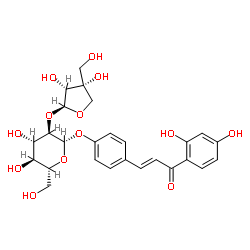120926-46-7
| Name | (E)-3-[4-[(2S,3R,4S,5S,6R)-3-[(2S,3R,4R)-3,4-dihydroxy-4-(hydroxymethyl)oxolan-2-yl]oxy-4,5-dihydroxy-6-(hydroxymethyl)oxan-2-yl]oxyphenyl]-1-(2,4-dihydroxyphenyl)prop-2-en-1-one |
|---|---|
| Synonyms |
2-Propen-1-one, 1-(2,4-dihydroxyphenyl)-3-[4-[[2-O-[(2S,3R,4R)-tetrahydro-3,4-dihydroxy-4-(hydroxymethyl)-2-furanyl]-β-D-glucopyranosyl]oxy]phenyl]-, (2E)-
4-[(1E)-3-(2,4-Dihydroxyphenyl)-3-oxo-1-propen-1-yl]phenyl 2-O-[(2S,3R,4R)-3,4-dihydroxy-4-(hydroxymethyl)tetrahydro-2-furanyl]-β-D-glucopyranoside Neolicuroside |
| Description | Isoliquiritin apioside, a component isolated from Glycyrrhizae radix rhizome, significantly decreases PMA-induced increases in MMP9 activities and suppresses PMA-induced activation of MAPK and NF-κB. Isoliquiritin apioside auppresseses invasiveness and angiogenesis of cancer cells and endothelial cells[1]. |
|---|---|
| Related Catalog | |
| Target |
MMP9 NF-κB p38 MAPK |
| In Vitro | Isoliquiritin apioside efficiently suppresses the PMA-induced gelatinolytic MMP-9 activity in HT1080 cells. Isoliquiritin apiosidealso decreases the PMA-induced increase in MMP-9 production in HT1080 cells.Isoliquiritin apioside possesses anti-metastatic and anti-angiogenic abilities in malignant cancer cells and endothelial cells (ECs), with no cytotoxicity[1]. |
| References |
| Density | 1.6±0.1 g/cm3 |
|---|---|
| Boiling Point | 901.0±65.0 °C at 760 mmHg |
| Molecular Formula | C26H30O13 |
| Molecular Weight | 550.509 |
| Flash Point | 301.9±27.8 °C |
| Exact Mass | 550.168640 |
| PSA | 215.83000 |
| LogP | 1.96 |
| Vapour Pressure | 0.0±0.3 mmHg at 25°C |
| Index of Refraction | 1.709 |


